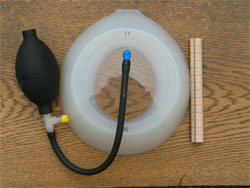Pectus excavatum
Editor-In-Chief: Prab R Tumpati, MD
Obesity, Sleep & Internal medicine
Founder, WikiMD Wellnesspedia &
W8MD medical weight loss NYC and sleep center NYC
| Pectus excavatum | |
|---|---|
| Synonyms | Funnel chest, sunken chest |
| Pronounce | N/A |
| Specialty | Thoracic surgery, Pediatrics |
| Symptoms | Chest pain, shortness of breath, fatigue |
| Complications | Cardiac compression, respiratory issues |
| Onset | Childhood |
| Duration | Lifelong |
| Types | N/A |
| Causes | Genetic factors, connective tissue disorders |
| Risks | Marfan syndrome, Ehlers-Danlos syndrome |
| Diagnosis | Physical examination, imaging studies |
| Differential diagnosis | Pectus carinatum, scoliosis |
| Prevention | None |
| Treatment | Surgical repair, physical therapy |
| Medication | Pain management |
| Prognosis | Generally good with treatment |
| Frequency | 1 in 300-400 births |
| Deaths | N/A |
Pectus excavatum, also known as "funnel chest" or "sunken chest", is a congenital chest wall deformity characterized by a concave, or caved-in, appearance of the sternum. The severity of the condition varies between individuals, and it can range from a mild indentation to a severe depression, potentially impacting surrounding organs.
Pathophysiology[edit | edit source]
Pectus excavatum results from an excessive growth and abnormal orientation of the costal cartilages, leading to the depression of the sternum. This growth disturbance is usually noted in the first year of life and becomes more pronounced during the rapid growth period of puberty. Although the exact cause is not known, it is believed to have a genetic component, as it frequently occurs in families and is often associated with other genetic disorders such as Marfan syndrome and Ehlers-Danlos syndrome.
Clinical Presentation[edit | edit source]
Clinically, the hallmark of pectus excavatum is a visibly sunken sternum, which can become more pronounced with growth or physical activity. The condition may cause discomfort or pain in the chest and back, and it may also affect respiratory function in severe cases, leading to shortness of breath, especially during physical activity. It is also common for individuals with pectus excavatum to experience feelings of self-consciousness due to the appearance of their chest.
Diagnosis[edit | edit source]
Diagnosis of pectus excavatum is typically made based on physical examination. Imaging studies, such as chest X-rays, CT scans, or MRI, may be used to assess the severity of the depression and its effect on the heart and lungs. Pulmonary function tests may also be performed to evaluate any breathing difficulties.
Management and Treatment[edit | edit source]
The management of pectus excavatum depends on the severity of the symptoms and the impact on the patient's quality of life. Mild cases without significant symptoms or functional impairment may not require any specific treatment except for regular monitoring. For moderate to severe cases, surgical correction may be recommended. The most common procedure is the Nuss procedure, a minimally invasive approach that involves the insertion of a curved metal bar to correct the shape of the sternum. Postoperative pain management is an essential part of the recovery process. Physical therapy exercises may also help to improve posture, increase lung capacity, and strengthen chest wall muscles.
Pectus_excavatum images[edit | edit source]
References[edit | edit source]
- Pectus Excavatum: History, Questions and Controversies
- The management of pectus excavatum: a comparative study of the Nuss and Ravitch procedures
- Physical therapy for a child with pectus excavatum and bilateral hip dysplasia: a case report
| This article is a medical stub. You can help WikiMD by expanding it! | |
|---|---|
| Medical examination and history taking | ||||||||||||||||||
|---|---|---|---|---|---|---|---|---|---|---|---|---|---|---|---|---|---|---|
|
Search WikiMD
Ad.Tired of being Overweight? Try W8MD's physician weight loss program.
Semaglutide (Ozempic / Wegovy and Tirzepatide (Mounjaro / Zepbound) available.
Advertise on WikiMD
|
WikiMD's Wellness Encyclopedia |
| Let Food Be Thy Medicine Medicine Thy Food - Hippocrates |
Translate this page: - East Asian
中文,
日本,
한국어,
South Asian
हिन्दी,
தமிழ்,
తెలుగు,
Urdu,
ಕನ್ನಡ,
Southeast Asian
Indonesian,
Vietnamese,
Thai,
မြန်မာဘာသာ,
বাংলা
European
español,
Deutsch,
français,
Greek,
português do Brasil,
polski,
română,
русский,
Nederlands,
norsk,
svenska,
suomi,
Italian
Middle Eastern & African
عربى,
Turkish,
Persian,
Hebrew,
Afrikaans,
isiZulu,
Kiswahili,
Other
Bulgarian,
Hungarian,
Czech,
Swedish,
മലയാളം,
मराठी,
ਪੰਜਾਬੀ,
ગુજરાતી,
Portuguese,
Ukrainian
Medical Disclaimer: WikiMD is not a substitute for professional medical advice. The information on WikiMD is provided as an information resource only, may be incorrect, outdated or misleading, and is not to be used or relied on for any diagnostic or treatment purposes. Please consult your health care provider before making any healthcare decisions or for guidance about a specific medical condition. WikiMD expressly disclaims responsibility, and shall have no liability, for any damages, loss, injury, or liability whatsoever suffered as a result of your reliance on the information contained in this site. By visiting this site you agree to the foregoing terms and conditions, which may from time to time be changed or supplemented by WikiMD. If you do not agree to the foregoing terms and conditions, you should not enter or use this site. See full disclaimer.
Credits:Most images are courtesy of Wikimedia commons, and templates, categories Wikipedia, licensed under CC BY SA or similar.
Contributors: Prab R. Tumpati, MD









